Photos & Story: Dan Milner
It’s weird. For the first time I’m wishing my backpack were heavier. Even bulging with overnight kit it feels too light, which means I’m out of water. We’re 3000 meters up on a remote Northern Argentinean mountainside, beneath a searing sun. And then comes the hammer blow: “We are half way now,” says Francisco, our local bike guide. We’ve been out on this trail five hours already today but it will be another four before we reach our day’s end point and can finally rehydrate. We look at our limp hydration reservoirs and then at each other. “I think we’d better get a move on,” says Hans Rey, his voice lacking its usual jovial tone.
Along with Hans, fellow rider Tibor Simai and TV cameraman Rob Summers I’m following Francisco across what is collectively being deemed one of the best adventure rides any of us has ever done: a three-day mountain traverse that starts among the cacti of desert mountains and finishes among super-sized spiders in lush rainforest. It’s 25 hours of incredible trail riding, but the rewards aren’t easily earned. We’ll climb 3000 meters and sweat over a 4100m pass. And we will run out of water, every day.
Day one sees an early start from the Andean Indian town of Tilcara. We grab one last chance to get a jump on the altitude with a jeep shuttle up 500 meters of rugged mountainside to our start point, a narrow gorge called the Gargantua del Diablo (‘Devil’s Throat’). With names like that I wonder what we’re letting ourselves in for. Here we hand overnight gear to our carguero, the horseman for the day. Renting horses means that today we get to ride the highest section of the trail unencumbered, but tomorrow the carguero heads home and our gear is on our backs. So for the moment I appreciate all the help I can get as we ride out from the 3000m-high trailhead. Winding through a forest of towering cacti we grind up the only section of jeep track we’ll see during three days of riding. A half hour later and we’re already onto singletrack.
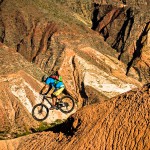 The best adventure rides usually demand some discomfort before spilling their rewards. Our traverse along the ‘Tilcara-to-Calilegua’ trail -named for its start and end points- does not pretend to be any different. The trail steepens and bikes are slung onto our backs to climb a set of switchbacks. We have over a thousand meters of ascent to reach the pass, but despite having been in the high desert for a week already, we’re left gasping in the thin air.
The best adventure rides usually demand some discomfort before spilling their rewards. Our traverse along the ‘Tilcara-to-Calilegua’ trail -named for its start and end points- does not pretend to be any different. The trail steepens and bikes are slung onto our backs to climb a set of switchbacks. We have over a thousand meters of ascent to reach the pass, but despite having been in the high desert for a week already, we’re left gasping in the thin air.
Our progress is a slow, methodical plod, red dust coating our shoes, sweat dripping from helmets. We climb a trail chiseled out of the hillside by centuries of animal and human traffic, through a colourful landscape that looks like a paint-by-numbers book gone wrong; the perfect distraction from our laboured breathing. Bridging the gap between jungle and mountains, this pre-Inca trail was once used to carry salt and llama meat eastwards, and tropical fruits and hallucinogenic plants on return. Centuries later, our trail has continued to elude the road-building bulldozers that have culled so much singletrack around the world. Horses are still the vehicles of choice here.
We’re tackling our adventure in March, at the end of the Argentina’s rainy season with warnings that we could even encounter snow. But today at least, our gamble has paid off: the weather is good. We puff up rock staircases and pedal along a dry, dusty trail, through a narrow cleft in the mountains. Learning to nto push it too hard allows us to granny ring up the last few hundred meters to the 4142m Campo Laguna pass. It’s a remote, wild but beautiful place, marked eerily by a solitary cairn and wooden cross. We’re jubilant and want to rest, but an incessant wind persuades us to move on. We watch a whole family -from grandmother to toddlers pass by on horseback- before rolling into our first descent of the day. It’s already 3pm.
 The fast, loose descent pitches us straight into a thick mist that rises from the sweating rainforest thousands of meters below. It makes every bend blind but it’s not unwelcome either: it gives a reprieve from the sun’s heat.
The fast, loose descent pitches us straight into a thick mist that rises from the sweating rainforest thousands of meters below. It makes every bend blind but it’s not unwelcome either: it gives a reprieve from the sun’s heat.
We roll a buttery smooth trail and quickly drop several hundred meters. Suddenly Tibor pulls up and we all nearly pile into his back wheel. Just ahead a landslide has ripped out the side of the mountain, taking the trail with it. This near miss is a reminder that we’re riding through untamed terrain. An injury here would mean at best a bumpy ride out on horseback, probably with a kid strapped to your lap, and at worst… well, the thought is pushed from our minds. We skirt around the cliff face and roll on, dropping down through a rhythmic set of switchbacks to disappear one-by-one into the void below.
The day takes us nine hours, and with 1350m of climbing, and over a thousand meters of descent behind us, we’re running on empty when we pull up at the first night’s accommodation: a remote, unmanned refuge. Inside is a set of bunkbeds, a stove and a solar powered 12v lamp. Its basic but no-one is complaining. Any anxieties we had at finishing our ride in almost zero visibility a mere half hour before dark are offset by the buzz we share of riding such an incredible, day of unrelenting singletrack. Helped by two bottles of red wine the carguero pulls from the horses’ saddlebags.
Although early, our trail has already gained a place in our hearts. The rewards of our efforts come thick and fast. Technical rock gardens feed to flow-trail traverses, and steep lung-crunching climbs ease into twisting descents they defy any bike-park to deliver better. Meanwhile the landscape around us slowly evolves, from barren rockfaces to tussock grasslands to lush green jungle.
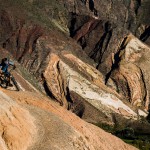 We leave our refuge under clear skies next morning, and ride into a 400-meter climb. We pedal up through mountains that glow neon green thanks to their daily misting. Today is the toughest of the three days –a 30 Km stretch of trail that packs in 1300 meters of climbing and 2650 meters of descent. The circling condors high above our heads seem like an omen. We freewheel across traverses perched high on steep hillsides, surrounded by a sea of 5000-meter peaks. To the east the tsunami of mist is rising, engulfing the mountains that lie in our sights.
We leave our refuge under clear skies next morning, and ride into a 400-meter climb. We pedal up through mountains that glow neon green thanks to their daily misting. Today is the toughest of the three days –a 30 Km stretch of trail that packs in 1300 meters of climbing and 2650 meters of descent. The circling condors high above our heads seem like an omen. We freewheel across traverses perched high on steep hillsides, surrounded by a sea of 5000-meter peaks. To the east the tsunami of mist is rising, engulfing the mountains that lie in our sights.
For three hours we pedal an undulating trail, the perfect way to cover ground when you have a full backpack. The finger-tingling chill that ushered us from the refuge has now gone, replaced by the heat of an unrelenting sun. We’re only 24 degrees south of the equator.
Our trail is a living lifeline between the villages it connects. Stopping to absorb yet another incredible panorama, we ponder life in such a wild, remote place. At what feels like the most remote part of the whole three-day traverse, we stumble upon a hilltop cemetery. Far below we can pick out the roofs of Molulo village. “Damn,” I say, “they carry coffins all the way up here.” “Or maybe they bury the dead right where they die!” adds Hans, looking around at the stark, uncompromising pass we’ve climbed to. And right on cue, we discover our ‘diminishing water’ issue.
Hydration is a very real issue on this trail, but not so when you reach the accommodation stops. When we roll into San Lucas –a village of 3 mud-brick houses, one of which will host us tonight- we’re greeted by a welcome stockpile of Quilmes beer. This village is a solid 3-hour hike from the nearest road, along a tiny thread of horse trail that is often washed out in the rainy season. So to find alcohol for sale is an indication that there is at least some tourism here. Over several bottles of frothing brew and a vast plate of cheese empanadas (Argentinean pasties) Francisco tells us of the handful of guided treks that now hike this amazing route. He also alarmingly retells our hosts’ stories of the few independent trekkers that have been lost in the thick jungle, some never found. I decide to keep Francisco in my sights.
It’s around San Lucas that we see the greatest change in our surroundings. Gone is the open high-mountain feel, replaced by almost impenetrable humid jungle. Weaving through it threads a ribbon of vivid red dirt –our trail. Typically no more than a half-meter wide, the trail flows around a hundred perfect bends, every one a photo opportunity. As I step into the undergrowth to find a good camera angle, I’m reminded that this is not North Wales. “Watch those plants, they sting!” warns Francisco, before listing a dozen other dangers of the forest, among them ants, jaguars and spiders. I back out of the undergrowth carefully.
The desert climate of our ride’s start is forgotten. We pour with sweat as we push up a couple of steep climbs, before welcoming the cool breeze of another winding descent. We pedal beneath ribbon waterfalls tumbling from red cliffs. Overhead flocks of green parakeets squawk. We roll along a narrow balcony suspended high above the muddy Valle Grande river and then spiral down bermed corners, all the time enveloped in a thousand hues of green. The air is humid but the trail is dry. To ride this trail in the wet would be insane.
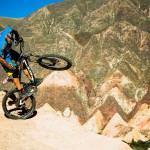 After twenty-five hours of riding and pushing we are finally slung full speed into the bottom of the gorge. Our facepacks of caked dirt, dust and sweat, are cracked by wide smiles that burst uncontrollably from within. We’re deep in the Calilegua National Park, the end of our ride. We stoop to wash the grime from our faces and look up to the final 30-minute push to the road. Mosquitos nip at our ankles and sweat-soaked jerseys cling to our bodies like entries in some perverse manly wet T-shirt competition. To some it sounds like hell. To us, we have found paradise. We have three days of adventure riding behind us, right over the roof of Argentina. It was tough, our legs ache and we’re scratching bites, but all we want to do now is turn around and ride it all again.
After twenty-five hours of riding and pushing we are finally slung full speed into the bottom of the gorge. Our facepacks of caked dirt, dust and sweat, are cracked by wide smiles that burst uncontrollably from within. We’re deep in the Calilegua National Park, the end of our ride. We stoop to wash the grime from our faces and look up to the final 30-minute push to the road. Mosquitos nip at our ankles and sweat-soaked jerseys cling to our bodies like entries in some perverse manly wet T-shirt competition. To some it sounds like hell. To us, we have found paradise. We have three days of adventure riding behind us, right over the roof of Argentina. It was tough, our legs ache and we’re scratching bites, but all we want to do now is turn around and ride it all again.
What, how and when?
Hans Rey lists our Tilcara-Calilegua trail is one of the best three adventure trails he’s ever ridden. We covered 60Km over three days, with 3180m of climbing and 4750m of descent, 99% on singletrack. Best time to ride is April to September (dry season). Francisco Jose (www.jujuyenbici.com.ar) offers guided trips with horse support, food, sleeping bags, accommodation, sat-phone back up and jeep transport from approx. $300 per person. He is based out of the quiet, comfortable hotel Gaia in Tilcara (gaiatilcara.com.ar). Fly direct from the UK to Argentinian capital Buenos Aires. Get to Tilcara by taking an internal flight (aerolineas.com.ar, 3 hrs, £250 rtn) or bus (22 hrs, £20) to Salta. Regular buses from Salta to Tilcara (4 hrs, £5) or Francisco can arrange a shuttle (3 hrs, £120 for up to 4 people).
Who the hell were the Incas?
Go back 500 years just before the Spanish pillaged South America and you’ll find the Incas in charge. Famous for their ‘inca trails’ and notably Macchu Picchu, the Inca empire was centered on Peru but also spread across Ecuador, Northern Chile and Argentina, Bolivia and parts of Columbia. Through colonization based on both conquest and peaceful assimilation they became the largest empire of the Americas; until the Spaniards arrived. Despite not having iron or steel, they were a force to be reckoned with, but ultimately fell foul to Spaniards armour and swords. They didn’t have the wheel, but they sure created some great singletrack trails.
3 keys to riding an epic.
- Hydrate –epics usually mean a compromise in hydration during the ride. A 5% drop in body weight due to sweating can cause up to 30% less muscle efficiency in hot climates. Ideally aim to drink 0.3L every half hour and carry water purifying tablets or a filter if there will be chance to re-fill a reservoir on the trail. If no refill is available, then make sure you’re hydrated before you start the ride and drink lots (of water) for 2 hours afterwards.
- Fuel –Top up on slow-release energy foods, such as Clif Shot Bloks every half hour during the ride to avoid the bonk, but carry something savoury and nutritious too. Nothing beats the morale boost of stopping to munch real sandwiches during an all-day epic. Think cheese and pickle, or if in Argentina, a couple of baked cheese pasties (empanadas).
- Know when to rest –Don’t be afraid to get off and push if it means you get to ride another day. Struggling up steep climbs at altitude will help red-blood cell production but will fill legs with lactic acid too while pushing exercises different muscles, allowing riding muscles to rest. Build in regular 5 minute breaks rather than a single hour long lunch stop to keep the legs from getting heavy. Use the stops to really take in the scenery/apply sunscreen. After all, you’re not riding in Birmingham.
Who are Hans Rey and Tibor Simai?
Swiss rider Hans Rey has been turning heads since winning the Trials World Championships in 1989. Perhaps the longest working professional mountain biker in history, five-times World trials champion Hans has turned his focus towards adventure. From riding volcanos in Ecuador to tracking down head-hunters in Borneo, Hans has kept adventure alive in mountain biking. He lives in Laguna Beach, California and rides for GT bikes, LUX, Adidas, FOX, Crank Brothers, Clif Bar, Muc-off, and Deuter packs. www.hansrey.com
Tibor Simai is a big lad. Former vice German champion in power lifting (that’s muscle-stuff to you and me) he came to mountain biking through dirt jumps and BMX (twice German champion) and 4X. His passion for riding is unbeatable, but he’s new to the adventure ride idea, but he has his uses. Carrying 95Kg and with a Schwarzenegger build there are few other riders you could count on to actually be able to carry you off the hill if things go wrong. Tibor rides for Canyon, Ergon, Marzocchi, 661, eThirteen, Oakley, Kenda and GoPro. www.tiborsimai.com
Between the Lines
“It’s the most shitty looking, crappiest trail I have ever seen,” says Hans, not mincing his words. We’re tired, hungry and cold and have found ourselves passing the night in the one-horse Argentinean border town of La Quiaca -a town that’s sole existence seems to be to encourage travellers to leave. Looking north, a concrete bridge spans a trickle of grubby water that separates Argentina from Bolivia, and to the south, extending as far as the eye can see across a desert landscape, is the trail along which we’re about to mountain bike. Or perhaps ‘trail’ is too generous a term for a 100-year old, disused railway line.
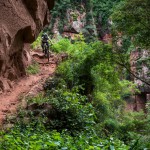 Completed in 1912 by British engineers, the one metre-gauge line that is to host our two-day ride was once the quickest and safest way to travel through the arid and bandit-infested desert North. Subsequent economic depression, then privatisation in the 1970’s and finally abandonment in 1992 means the steam trains that once plied the Belgrano Norte line have long since disappeared. But the line itself remains –a straight, level track slicing through some of the World’s most impressive scenery.
Completed in 1912 by British engineers, the one metre-gauge line that is to host our two-day ride was once the quickest and safest way to travel through the arid and bandit-infested desert North. Subsequent economic depression, then privatisation in the 1970’s and finally abandonment in 1992 means the steam trains that once plied the Belgrano Norte line have long since disappeared. But the line itself remains –a straight, level track slicing through some of the World’s most impressive scenery.
It’s taken me six years to get to this point, having first laid eyes on this iron-railed remnant of industrial history during a previous bike trip here. During one of those seemingly regular moments of madness I succumbed to the idea that to mountain bike along this old railway line might make an interesting interlude in my life. It would be a challenge, I reasoned, but no doubt strangely rewarding. Travelling by bike means immersing yourself in your environment. It means seeing things that otherwise pass by too quickly from the seat of a bus. It means coming home with experiences and rewards that are not listed in the guide book. And so the romantic notion of an adventure was spawned in that way they so often are: peering from the window of an air-conditioned rental as I sped along a silky smooth tarmac road.
Now as we sit in a café chewing stale pastries and supping on hot chocolates as part of the Argentinean afternoon-tea tradition, I’m a little hurt by Hans’ remark. Don’t get me wrong; I have no warmth for this grimy town or our $10 hotel, run by Argentina’s laziest proprietor. But the reason I and fellow mountain bikers Hans Rey, Tibor Simai and Rob Summers are here, is down to my sense of what makes a good adventure. This railway is my baby. I’ve researched it, squinting at its feint form on GoogleEarth and missing last orders at the local while at home pondering logisitics and viability. But I realise there is some truth about Hans’ comment that is striking a chord in me too. The last bus we took paralleled the railway for 40 Km allowing us a preview of what we’re embarking on, and while adventure is nigh-on guaranteed, the actual riding actually didn’t look too promising. Swallowed up by drifts of sand, overgrown by sagebrush and teetering over a dozen broken bridges, my chosen mountain bike trail is no weekend ride in the Surrey hills. I guess its why no one has tried to ride it before.
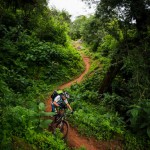 The sun is low but I can already feel its savage bite as we start our escapade next morning. Over two days we’ll attempt to ride as much of the railway as we can, starting at Abra Pampa and finishing among the cobble-streets of Humahuaca, 100 Km to the south. A decade living near the Bristol-Bath commuter bike path familiarised me with the easy-going gradients of railway lines converted to bike thoroughfares. Typically they produce the kind of inclines that let you mash gears in never ending sprints, working on cardio-vascular targets while dodging potential muggings.
The sun is low but I can already feel its savage bite as we start our escapade next morning. Over two days we’ll attempt to ride as much of the railway as we can, starting at Abra Pampa and finishing among the cobble-streets of Humahuaca, 100 Km to the south. A decade living near the Bristol-Bath commuter bike path familiarised me with the easy-going gradients of railway lines converted to bike thoroughfares. Typically they produce the kind of inclines that let you mash gears in never ending sprints, working on cardio-vascular targets while dodging potential muggings.
But this time it’s the altitude that does the mugging. In Abra Pampa’s corner shop we wade through a sea of bowler-hat wearing indigenous Indian women to fill our backpacks with bananas and water before pedalling to the railway line and straight into a 20 Km long climb. I’m right about the easy gradient, but faced with an incessant headwind and the lung-crunch of riding at 3400 metres of altitude, this initial gentle but unrelenting climb proves harder than any of us envisaged. A month of regular turbo-trainer sessions in my garage seems to have done little to help right now and my legs feel heavy and useless. Repeatedly we’re forced off our bikes to climb over barbed-wire fences that now pay little respect to the railway engineers’ noble notion of cutting an unimpeded course across the landscape. Herds of llamas and guanaco stand their ground, unaccustomed to being confronted by bikers, and we’re forced off the line to roll down the embankment only to have to haul ourselves back up again to continue.
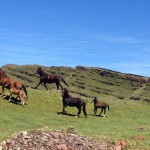 By mid morning we’re feeling the full ferocity of the sun. There is no shade here and in three days time we’ll all be shedding skin like serpents at a clothes swap. The vast altiplaneau we’re traversing is criss-crossed by dozens of small, dry creek beds, each spanned by a railway bridge that hasn’t seen maintenance for 20 plus years. Some are intact, their sleepers still evenly spaced about 30 cm apart, allowing us to ride across them if we carry momentum, but some wield gaping holes where sleepers have disappeared. Others yet have been reduced to nothing more than a twisted tangle of ironwork. The approach of every bridge brings a tingle of apprehension, and crossing them becomes a game of calculations and nerves.
By mid morning we’re feeling the full ferocity of the sun. There is no shade here and in three days time we’ll all be shedding skin like serpents at a clothes swap. The vast altiplaneau we’re traversing is criss-crossed by dozens of small, dry creek beds, each spanned by a railway bridge that hasn’t seen maintenance for 20 plus years. Some are intact, their sleepers still evenly spaced about 30 cm apart, allowing us to ride across them if we carry momentum, but some wield gaping holes where sleepers have disappeared. Others yet have been reduced to nothing more than a twisted tangle of ironwork. The approach of every bridge brings a tingle of apprehension, and crossing them becomes a game of calculations and nerves.
We’re only ten kilometres out of town but already the feeling of space is immense. Above us a vast blue sky reaches down to touch the rugged peaks of the Andes. The line’s one-metre gauge just gives us enough space to manoeuvre between the rails and we swerve around the clumps of prickly brush that thrust randomly from the earth, and hop over randomly projecting sleepers. With a little momentum picking a line through the undergrowth begins to deliver a rhythmic flow to the riding, like railing good singletrack.
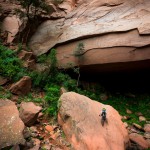 It becomes apparent that left untendered, the railway is slowly being re-absorbed in to the environment by nature. Gopher burrows acne the ground and adjacent telegraph poles, relieved of their messaging duties have relaxed their guard. Their broken wires hang limp and their Bakelite fixtures have become platforms for tangled weaverbird nests
It becomes apparent that left untendered, the railway is slowly being re-absorbed in to the environment by nature. Gopher burrows acne the ground and adjacent telegraph poles, relieved of their messaging duties have relaxed their guard. Their broken wires hang limp and their Bakelite fixtures have become platforms for tangled weaverbird nests
Thankfully for us the wooden sleepers have long since become buried under drifting sand, now baked hard under decades of unrelenting sun and making the riding easier. In places the sleepers have disappeared completely, seized as hallowed building materials by locals in the absence of both trees or a branch of B&Q. In the absence of such ground anchors, here the rails have become bent and contorted by the desert heat.
We’re parched and burnt by the time we reach our first day’s finish, Tres Cruces, a small village that is little more than a jumping off stop for the nearby Uranium mine. Accommodation, or more accurately lack of, has been a big challenge in planning this adventure, with few villages positioned along the line. Some towns in the area, such as Humahuaca or Tilcara, have become tourism hotspots and accommodation is guaranteed, but at tiny Tres Cruces we’re taking a gamble. We lose. Locals point us to the one hotel in the village, but it clearly hasn’t been open for years. Opting to travel light without camping gear, and now faced with night-time temperatures well below zero, we have little option but to jump on a bus back to Abra Pampa for the night and return to Tres Cruces at dawn to continue our ride onwards. It’s a frustrating turn of events and in hindsight maybe throwing in a sleeping bag each would have been wise. Then we’d have been able to entertain our grandkids with stories of how we slept out in an old disused railway wagon in a ghost town of a village near a Uranium mine. My, we missed a trick there.
Nothing wakes you up quite like a 7am ride in the back of a pick up truck speeding across a desert plateau at 3400 metres. Still wearing down jackets we’re delivered back at Tres Cruces abandoned station early enough to get a jump on the heat of the day. We pedal out beneath towering water tanks that once flooded the boilers of steam engines and past rusting signalling pylons. It’s like riding through a museum.
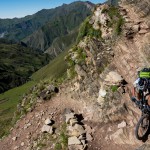 We’re in good spirits, helped by the start of a gentle descent into the Rio Grande valley. We skip across bridges and up the pace to cross lengths of railway left suspended in mid air by the undercutting action of the adjacent river. Our progress is humbled by a landscape of colourful rock layers, each twisted and thrown into disarray by unfathomable geological forces. We pass a remote hilltop cemetery at 3800 metres, its iron crosses decorated with rosary beads, ribbons and cheap plastic posies. Scattered animal bones bleached white by the sun and the desiccating corpse of a llama serve to remind us of the possibilities should something go wrong out here. “But what can?” we ask ourselves. After all, we’re just riding along an old railway line, the shortest and easiest way from A-to-B.
We’re in good spirits, helped by the start of a gentle descent into the Rio Grande valley. We skip across bridges and up the pace to cross lengths of railway left suspended in mid air by the undercutting action of the adjacent river. Our progress is humbled by a landscape of colourful rock layers, each twisted and thrown into disarray by unfathomable geological forces. We pass a remote hilltop cemetery at 3800 metres, its iron crosses decorated with rosary beads, ribbons and cheap plastic posies. Scattered animal bones bleached white by the sun and the desiccating corpse of a llama serve to remind us of the possibilities should something go wrong out here. “But what can?” we ask ourselves. After all, we’re just riding along an old railway line, the shortest and easiest way from A-to-B.
And then the bridges loom into view. Each is perhaps 50 meters long and suspended 30 meters above a chocolate coloured Rio Grande and there are two to cross. Even encountered separately, each could be a contender for the most mentally challenging part of our two-day adventure. Too long and with too many gaping holes due to missing sleepers to try to ride across, we’ll be walking these. But like their smaller brethren we’ve already negotiated, the bridges have no walkway, no handrails, only the rails and wooden sleepers and gaps between them, lots of gaps.
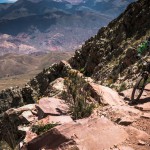 I gingerly step onto the first bridge, trusting the decrepit ironwork while cursing the blustery cross wind that has arrived to add to the drama. Never good with heights, I fight the urge to peer down into the void that beckons between each sleeper, while hoping my cleated bike shoes will give me the sure-footedness I need to stay upright. An attempt to wheel my bike quickly fails, its front wheel dropping into the first broken gap and the rest of the bike nearly following onto the abyss. My impoverished railway-bridge crossing skills nearly cost me my bike. I wrench it out and haul it above the rails, wondering how or where you might be able to practice and hone such skills before coming on such trips?
I gingerly step onto the first bridge, trusting the decrepit ironwork while cursing the blustery cross wind that has arrived to add to the drama. Never good with heights, I fight the urge to peer down into the void that beckons between each sleeper, while hoping my cleated bike shoes will give me the sure-footedness I need to stay upright. An attempt to wheel my bike quickly fails, its front wheel dropping into the first broken gap and the rest of the bike nearly following onto the abyss. My impoverished railway-bridge crossing skills nearly cost me my bike. I wrench it out and haul it above the rails, wondering how or where you might be able to practice and hone such skills before coming on such trips?
By the time I reach the ‘safe’ end of the second bridge my mouth is dry, my legs wobbling and my forearm cramping from the vice-like grip I’ve exerted on my bike. But as I slump down onto the railway siding and regain control over my breathing I realise the worst is behind me. Even from behind the windscreen of my rental car six years earlier, I knew these two bridges would present the biggest challenge should I come back to ride this railway line. With no idea of how safe they were, I’d even entertained thoughts of lugging an inflatable pack-raft with us to use to cross the river instead.
 I watch as my fellow mountain bikers make the same crossing behind me, each caught up in their own mix of adrenaline, focus and sense of accomplishment. ‘For every tough mountain bike trail there is always one harder,’ I think, and for every remote adventure, there is always another just as unique. I realise that while the adrenaline rush of riding somewhere new, somewhere no one has ridden before, comes thick and fast, that buzz is ephemeral. For me the lasting resonance of adventure is in what you learn about yourself and in those that share your experiences.
I watch as my fellow mountain bikers make the same crossing behind me, each caught up in their own mix of adrenaline, focus and sense of accomplishment. ‘For every tough mountain bike trail there is always one harder,’ I think, and for every remote adventure, there is always another just as unique. I realise that while the adrenaline rush of riding somewhere new, somewhere no one has ridden before, comes thick and fast, that buzz is ephemeral. For me the lasting resonance of adventure is in what you learn about yourself and in those that share your experiences.
I swing my leg back over my bike. Humahuaca is still another 30 Km away; 30 Km along one of the ‘crappiest’ trails I have ever ridden. We set off again, not knowing what lies around the corner, but knowing that so far it has become fun. I look back. Even Hans is smiling.
It’s (partly) about the bike
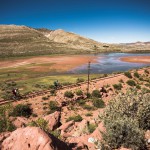 Today’s suspension bikes are the true do-it-all mountain bikes, but you needn’t break the bank for a steed that’s more than capable of carrying you through an adventure like this. While picking up an old hardtail from eBay works fine for less aggressive trail riding -like an old railway line in Argentina- a little suspension goes a long way towards comfort, and helping you finish your epic in one piece. Trek’s Fuel EX bike (trekbikes.com) is one of the most versatile rigs out there, with snappy-handling geometry and 120mm of suspension travel, it is a bike that is at home on any UK trail as it is on any far-flung expedition. Prices start at £1500 for the Fuel EX5, but we think that little bit more for the spec of the EX7 or above is worth it.
Today’s suspension bikes are the true do-it-all mountain bikes, but you needn’t break the bank for a steed that’s more than capable of carrying you through an adventure like this. While picking up an old hardtail from eBay works fine for less aggressive trail riding -like an old railway line in Argentina- a little suspension goes a long way towards comfort, and helping you finish your epic in one piece. Trek’s Fuel EX bike (trekbikes.com) is one of the most versatile rigs out there, with snappy-handling geometry and 120mm of suspension travel, it is a bike that is at home on any UK trail as it is on any far-flung expedition. Prices start at £1500 for the Fuel EX5, but we think that little bit more for the spec of the EX7 or above is worth it.
The EX is more than capable of smashing trails on your next Alps trip too, but if you’re a little heavier-hitting or feel the need for more confidence-inspiring geometry and a little extra get-you-out-of-trouble suspension travel, then the Trek Remedy could be your ticket. The Remedy is 150mm of travel in a real all-mountain package that can nail any trail, anywhere, if you have the resilience to test it. The Remedy starts at £2700.
Flying your bike
 Getting your bike to the start of your epic can sometimes be an epic in itself, but a few pointers on how to pack it can make or literally break your trip. I’ve been using the well-designed EVOC Bike Travel Bag (£299 silverfish-uk.com) to haul bikes for a while now with no complaints, liking the stable way it wheels along, and its great system for protecting the bike in transit. If you’re on a budget though, you could do worse than pick up a free cardboard bike box from your local bike shop. Whatever you transport your bike in, you’ll need to remove the front wheel and pop a spacer in the forks to strengthen them from side loading (a rolled up bit of cardboard cut to the inside width of the fork’s dropouts works well, same if you have to remove the rear wheel). Remove disc rotors, the rear derailleur, pedals and handlebars. Try to pack each item with padding such as bubble-wrap and stuff as much extra lightweight clothing into the box to minimise the amount of movement of the bike in transit. Add another layer of cardboard (cut from a second bike box) inside each side of the box to really help withstand baggage-handlers best efforts. Deflate tyres a little (leave some air in for impact protection), throw in a few spares such as a couple of spokes and a spare derailleur hanger and you’re good to get there in one piece, with a bike that works.
Getting your bike to the start of your epic can sometimes be an epic in itself, but a few pointers on how to pack it can make or literally break your trip. I’ve been using the well-designed EVOC Bike Travel Bag (£299 silverfish-uk.com) to haul bikes for a while now with no complaints, liking the stable way it wheels along, and its great system for protecting the bike in transit. If you’re on a budget though, you could do worse than pick up a free cardboard bike box from your local bike shop. Whatever you transport your bike in, you’ll need to remove the front wheel and pop a spacer in the forks to strengthen them from side loading (a rolled up bit of cardboard cut to the inside width of the fork’s dropouts works well, same if you have to remove the rear wheel). Remove disc rotors, the rear derailleur, pedals and handlebars. Try to pack each item with padding such as bubble-wrap and stuff as much extra lightweight clothing into the box to minimise the amount of movement of the bike in transit. Add another layer of cardboard (cut from a second bike box) inside each side of the box to really help withstand baggage-handlers best efforts. Deflate tyres a little (leave some air in for impact protection), throw in a few spares such as a couple of spokes and a spare derailleur hanger and you’re good to get there in one piece, with a bike that works.
What Bike – on the cheap
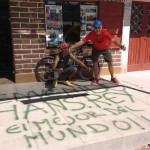 There are few sports out there that both are so accessible to all and lend themselves so easily to adventure as riding a bike. The mountain bike is an excuse to travel, but getting yourself sorted with the right set up it needn’t add to the challenge. Top drawer suspension bikes have the benefits of being light, strong and incredible capable but come with a price tag and the risk that if something does go wrong, then you’re unlikely to find parts or a mechanic to fix it in the more remote parts of the world. Sorting yourself an older hardtail rig will do the job admirably on a trip like this one, just make sure its serviced before you go. When deciding on spec or upgrades, think about the kind of riding you’re planning to do. Are you going to charge 3000 m descents or pedal a relatively flat railway line? Older V-brakes or cable disc brakes are not as effective as hydraulic discs but there is less to go wrong. Bike shops are everywhere in some basic form, but they wont stock the spokes for fancy wheels or ten-speed shifters. You’ll almost certainly find simple straight gauge spokes and eight speed spares though. Carry enough emergency parts to get yourself out of trouble: a couple of spare spokes, a replacement SRAM chain link, tyre patch, inner tube and patches, a couple of gear cables and a replacement rear derailleur hanger to start with. Throw in a lightweight multi-tool, pump and a little know how gleaned from a hundred possible Youtube videos and you’re nigh on self-sufficient. A water bottle cage on the bike takes 750g off your back and even adding a rear luggage rack could be key if you want to haul a sleeping bag and bivi bag too.
There are few sports out there that both are so accessible to all and lend themselves so easily to adventure as riding a bike. The mountain bike is an excuse to travel, but getting yourself sorted with the right set up it needn’t add to the challenge. Top drawer suspension bikes have the benefits of being light, strong and incredible capable but come with a price tag and the risk that if something does go wrong, then you’re unlikely to find parts or a mechanic to fix it in the more remote parts of the world. Sorting yourself an older hardtail rig will do the job admirably on a trip like this one, just make sure its serviced before you go. When deciding on spec or upgrades, think about the kind of riding you’re planning to do. Are you going to charge 3000 m descents or pedal a relatively flat railway line? Older V-brakes or cable disc brakes are not as effective as hydraulic discs but there is less to go wrong. Bike shops are everywhere in some basic form, but they wont stock the spokes for fancy wheels or ten-speed shifters. You’ll almost certainly find simple straight gauge spokes and eight speed spares though. Carry enough emergency parts to get yourself out of trouble: a couple of spare spokes, a replacement SRAM chain link, tyre patch, inner tube and patches, a couple of gear cables and a replacement rear derailleur hanger to start with. Throw in a lightweight multi-tool, pump and a little know how gleaned from a hundred possible Youtube videos and you’re nigh on self-sufficient. A water bottle cage on the bike takes 750g off your back and even adding a rear luggage rack could be key if you want to haul a sleeping bag and bivi bag too.
See the world, and learn from it [working title]
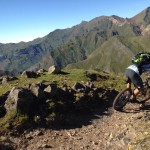 It’s surprising how beautifully simple life can become once you’re out on an adventure. After all, if your days are spent riding then you’ll probably get by with only one set of spare clothes aside from your ride kit. Life becomes simple but it’s often only after a couple of weeks living out of a single backpack that the beauty of this simple existence becomes clear. Internet cafes, although slow with confusing keyboards, make hauling that laptop redundant. Washing clothes in the shower and wringing them in a towel will mean you have clean, and dry kit for the next day. Learning a few phrases before you go can be key to both breaking down barriers and actually finding something to eat, but you’ll be surprised how little local lingo you need to get by if you show a smiling face and approach with polite enthusiasm. Being on a bike is a big help in breaking down social barriers. Everyone, everywhere identifies with the bike. Pull some wheelies with local kids, let their uncle try your bike, share a picture or two from your pocket. Carry a water filter to make sure your hydration is safe and eat wisely by avoiding unwashed salads and unpeeled fruit, but don’t be shy of local dishes or street food if you can see it being cooked. Every adventure has some risk, but weigh that up against the bigger risk in missing out by staying home and it’s a no-brainer.
It’s surprising how beautifully simple life can become once you’re out on an adventure. After all, if your days are spent riding then you’ll probably get by with only one set of spare clothes aside from your ride kit. Life becomes simple but it’s often only after a couple of weeks living out of a single backpack that the beauty of this simple existence becomes clear. Internet cafes, although slow with confusing keyboards, make hauling that laptop redundant. Washing clothes in the shower and wringing them in a towel will mean you have clean, and dry kit for the next day. Learning a few phrases before you go can be key to both breaking down barriers and actually finding something to eat, but you’ll be surprised how little local lingo you need to get by if you show a smiling face and approach with polite enthusiasm. Being on a bike is a big help in breaking down social barriers. Everyone, everywhere identifies with the bike. Pull some wheelies with local kids, let their uncle try your bike, share a picture or two from your pocket. Carry a water filter to make sure your hydration is safe and eat wisely by avoiding unwashed salads and unpeeled fruit, but don’t be shy of local dishes or street food if you can see it being cooked. Every adventure has some risk, but weigh that up against the bigger risk in missing out by staying home and it’s a no-brainer.

